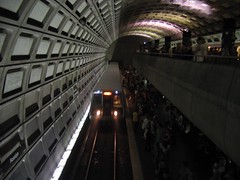 With an updated model of rider flows thanks to better data from WMATA, we can better understand crowding on Metrorail. Last week, We Love DC analyzed Metro crowding. They argued that Red Line riders have it worst because the Red Line carries 48% more riders than the Orange Line. However, the overall number of riders on the line as a whole is not enough to accurately measure congestion.
With an updated model of rider flows thanks to better data from WMATA, we can better understand crowding on Metrorail. Last week, We Love DC analyzed Metro crowding. They argued that Red Line riders have it worst because the Red Line carries 48% more riders than the Orange Line. However, the overall number of riders on the line as a whole is not enough to accurately measure congestion.The proportion of commuters in each direction matters as well. For instance, if we have two equivalent lines, each with the same ridership, and 90% of Line A's AM peak trips are inbound while only 60% of Line B's are, Line A will be more congested. It would still be more congested even if Line B had 10% more riders.
Another factor that must be considered is the spreading of trips along the line. Not every rider starts at a suburban terminal and rides to downtown. Some start at suburban terminals and ride to suburban office centers, while others start in urban neighborhoods and ride into or through downtown. The Red Line is the longest line and has more stations than the Orange Line, so more riders are to be expected.
Finally, the amount of rail service impacts congestion. The Red Line does not share trackage with any other rail line. This means that the number of trains per hour is higher on the Red Line than it is on the Orange Line, which shares tracks with the Blue Line.
With these factors in mind, let's look at rider volumes. The link with the most riders in the system, according to my analysis, is the inbound Blue/Orange shared segment between Rosslyn and Foggy Bottom, which carries 44,719 people between opening and 9:30 AM. In second place is the next link inbound, from Foggy Bottom to Farragut West, carrying 41,137 riders during that period. In third place comes the Red Line, with 31,773 trips from Dupont Circle to Farragut North. This means that the most used section of track of the Red Line carries only 70% as many riders as the busiest section of track on the Blue and Orange Lines.
But the real crux of the issue becomes clear at the Rosslyn junction point. At Rosslyn, 65% of inbound riders are on the Orange Line, but only 60% of trains are on the Orange Line. That means that passenger demand slightly outstrips the supply of railcars at that point. And the inbound track between Court House and Rosslyn is the 7th busiest in the system during the AM Peak.










No comments:
Post a Comment